- Accueil
- Pages cachées
- 25 FEVRIER 2024 NEWS
25 FEVRIER 2024 NEWS
INSTITUT SUPERIEUR D'ANTHROPOLOGIE
INSTITUTE OF ANTHROPOLOGY
ONLINE COURSES / COURS A DISTANCE
INSCRIPTIONS OUVERTES
REGISTER NOW
ANGLETERRE –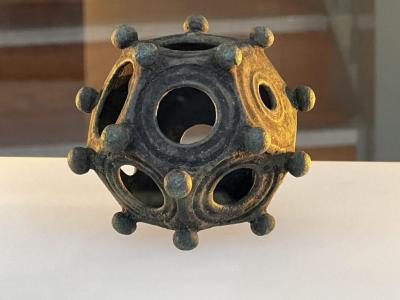 Norton Disney - The Norton Disney History and Archeology Group was digging in a field near the village of Norton Disney in Lincolnshire, England last summer when one of the volunteers stumbled upon a Roman dodecahedron. “It’s in an excellent condition—considering it’s been buried for 1,700 years,” group secretary Richard Parker said of the dodecahedron, a small, hollow object made from copper alloy and consisting of 12 pentagonal sides with circular cutouts at their center and studs on each corner. It’s not the first of its kind—over 30 dodecahedra have been discovered in the UK alone, many of them fragmented or damaged. But while these oddly shaped artifacts show up rather frequently in Rome’s archeological record, no one knows what they were used for. Because there are no surviving visual or textual references to dodecahedra, archeologists can do little except speculate. Some believe that the objects may have functioned as measuring devices or calendars, while others think they were used as weapons or tools, possibly for knitting. Instead, the group believes that the dodecahedra were used for “ritual and religious purposes.” This isn’t unthinkable. For one, most dodecahedra show little to no sign of wear and tear from handling, suggesting their use was ornamental rather than practical. It would also explain why the objects, some of which date to the first century CE, are not mentioned by ancient sources: as a pagan symbol, any references to the dodecahedron could well have been erased from public records after Christianity became the Roman Empire’s official religion.
Norton Disney - The Norton Disney History and Archeology Group was digging in a field near the village of Norton Disney in Lincolnshire, England last summer when one of the volunteers stumbled upon a Roman dodecahedron. “It’s in an excellent condition—considering it’s been buried for 1,700 years,” group secretary Richard Parker said of the dodecahedron, a small, hollow object made from copper alloy and consisting of 12 pentagonal sides with circular cutouts at their center and studs on each corner. It’s not the first of its kind—over 30 dodecahedra have been discovered in the UK alone, many of them fragmented or damaged. But while these oddly shaped artifacts show up rather frequently in Rome’s archeological record, no one knows what they were used for. Because there are no surviving visual or textual references to dodecahedra, archeologists can do little except speculate. Some believe that the objects may have functioned as measuring devices or calendars, while others think they were used as weapons or tools, possibly for knitting. Instead, the group believes that the dodecahedra were used for “ritual and religious purposes.” This isn’t unthinkable. For one, most dodecahedra show little to no sign of wear and tear from handling, suggesting their use was ornamental rather than practical. It would also explain why the objects, some of which date to the first century CE, are not mentioned by ancient sources: as a pagan symbol, any references to the dodecahedron could well have been erased from public records after Christianity became the Roman Empire’s official religion.
https://news.artnet.com/art-world/roman-dodecahedron-found-england-origin-mystery-2438189
POLOGNE – 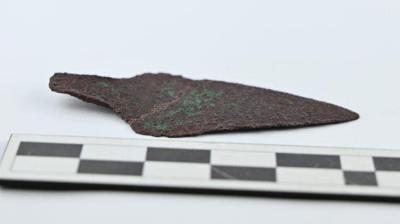 Korzenica - A copper dagger more than 4,000 years old was found in a forest near the town of Jarosław on the San River in south-eastern Poland. This discovery is the oldest dagger made of metal found in the Podkarpackie Voivodeship. This valuable object, dating back over 4,000 years, was discovered last November by Piotr Gorlach of the Jarosław Historical and Exploration Association, who – with the permission of the Podkarpacie Regional Historical Monument Conservator in Przemyśl – conducted a search with a metal detector in the forests in the area of the Jarosław Forest Inspectorate, near the village of Korzenica. Archaeologists from the Museum in Jarosław Orsetti House identified the artifact as an extremely rare 4,000-year-old dagger. The ancient weapon was made of copper and measured just over 4 inches (10,5 cm) in length. According to archaeologist Dr. Marcin Burghardt from the Jarosław Museum, the dagger discovered in Korzenica can be dated to the second half of the third millennium BC. “In Polish lands, this is a period of enormous changes related to, among others, with a change in the main raw materials for the production of tools. Instead of flint tools commonly used in the Stone Age, more and more metal products appear, heralding the transition to the next period – the Bronze Age,” noted Dr. Burghardt.
Korzenica - A copper dagger more than 4,000 years old was found in a forest near the town of Jarosław on the San River in south-eastern Poland. This discovery is the oldest dagger made of metal found in the Podkarpackie Voivodeship. This valuable object, dating back over 4,000 years, was discovered last November by Piotr Gorlach of the Jarosław Historical and Exploration Association, who – with the permission of the Podkarpacie Regional Historical Monument Conservator in Przemyśl – conducted a search with a metal detector in the forests in the area of the Jarosław Forest Inspectorate, near the village of Korzenica. Archaeologists from the Museum in Jarosław Orsetti House identified the artifact as an extremely rare 4,000-year-old dagger. The ancient weapon was made of copper and measured just over 4 inches (10,5 cm) in length. According to archaeologist Dr. Marcin Burghardt from the Jarosław Museum, the dagger discovered in Korzenica can be dated to the second half of the third millennium BC. “In Polish lands, this is a period of enormous changes related to, among others, with a change in the main raw materials for the production of tools. Instead of flint tools commonly used in the Stone Age, more and more metal products appear, heralding the transition to the next period – the Bronze Age,” noted Dr. Burghardt.
https://arkeonews.net/metal-detectorist-finds-on-4000-year-old-dagger-in-poland-forests/
ITALIE – 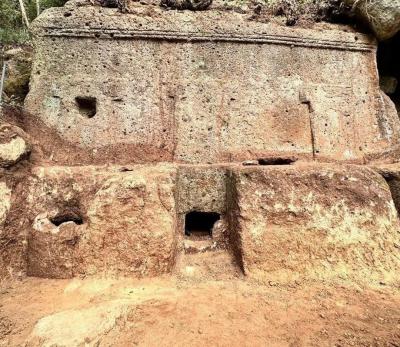 Barbarano - After years of work, archaeologists discovered an impressive Etruscan tomb partially hidden underground in the rock-cut necropolis of San Giuliano in Barbarano, north of Rome. The Etruscan Necropolis of San Giuliano is carved into the reddish rocks of the Marturanum Park, a protected natural area in the municipality of Barbarano Romano, on the road between Rome and Viterbo, in the heart of Southern Etruria. According to archaeologists, no known Etruscan necropolis presents such a variety and richness of burial types as San Giuliano. Dating back to the 7th century BC, it stands on the sides of a tufaceous cliff occupied by a stable settlement already during the Bronze Age. The discovery was made while researchers were cleaning and consolidating some of the site’s most representative rock-cut funerary chambers, which date from the seventh to third centuries BCE. The “Tomb of the Queen” (Tomba della Regina), one of the most important tombs in the necropolis, was chosen for consolidation and restoration work this season. It is a grandiose three-sided semi-dado carved into the rock, 14m wide and 10m high, dating from the 5th century BC. Its name probably derives from the majesty of its size. This type of tomb is common along the rocky wall facing the plateau of San Giuliano, where the ancient settlement stood, and it represents the expression of new changes in Etruscan society: new social classes emerge and fill the gap that once existed between aristocrats and the humble population. During a clearance operation around the Queen’s Tomb, archaeologists noticed what appeared to be a second semi-buried monumental tomb. After carefully removing the dense vegetation, the structure emerged in all its grandeur. Excavations carried out to clear the façade in fact uncovered a further three-chambered tomb surmounted by three semi-flint doors, subsequent to the Queen’s tomb, perfectly preserved in its architectural part. Experts believe it was built in the fifth or fourth century BCE, shortly after the nearby Queen’s Tomb. The tomb also highlights the technical mastery of Etruscan culture in excavating monumental funerary structures within cliffs and rocky slopes. Conservation and adaptation work on the newly discovered tombs is expected to be completed in the coming months.
Barbarano - After years of work, archaeologists discovered an impressive Etruscan tomb partially hidden underground in the rock-cut necropolis of San Giuliano in Barbarano, north of Rome. The Etruscan Necropolis of San Giuliano is carved into the reddish rocks of the Marturanum Park, a protected natural area in the municipality of Barbarano Romano, on the road between Rome and Viterbo, in the heart of Southern Etruria. According to archaeologists, no known Etruscan necropolis presents such a variety and richness of burial types as San Giuliano. Dating back to the 7th century BC, it stands on the sides of a tufaceous cliff occupied by a stable settlement already during the Bronze Age. The discovery was made while researchers were cleaning and consolidating some of the site’s most representative rock-cut funerary chambers, which date from the seventh to third centuries BCE. The “Tomb of the Queen” (Tomba della Regina), one of the most important tombs in the necropolis, was chosen for consolidation and restoration work this season. It is a grandiose three-sided semi-dado carved into the rock, 14m wide and 10m high, dating from the 5th century BC. Its name probably derives from the majesty of its size. This type of tomb is common along the rocky wall facing the plateau of San Giuliano, where the ancient settlement stood, and it represents the expression of new changes in Etruscan society: new social classes emerge and fill the gap that once existed between aristocrats and the humble population. During a clearance operation around the Queen’s Tomb, archaeologists noticed what appeared to be a second semi-buried monumental tomb. After carefully removing the dense vegetation, the structure emerged in all its grandeur. Excavations carried out to clear the façade in fact uncovered a further three-chambered tomb surmounted by three semi-flint doors, subsequent to the Queen’s tomb, perfectly preserved in its architectural part. Experts believe it was built in the fifth or fourth century BCE, shortly after the nearby Queen’s Tomb. The tomb also highlights the technical mastery of Etruscan culture in excavating monumental funerary structures within cliffs and rocky slopes. Conservation and adaptation work on the newly discovered tombs is expected to be completed in the coming months.
ANGLETERRE – 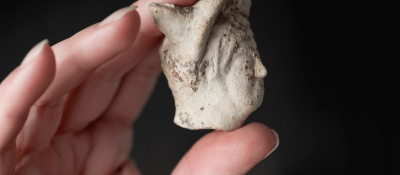 Smallhythe - At a previously unknown Roman settlement that was formerly next to a busy port but is now 10 miles from the sea, a very rare clay figurine of the god Mercury—one of less than 10 found in Britain—was found. The settlement, located in the modern hamlet of Smallhythe (or Small Hythe), near Tenterden in Kent, is surrounded by fields but was once an important link in the Roman Empire’s import and infrastructure network in southern England and the Channel. While excavating the National Trust plot, archaeologists came across earlier evidence of a Roman settlement, in use between the 1st and 3rd centuries. The settlement was small in scale and modest in prestige, said Cohen. “It’s not Roman Londinium, it’s not Cirencester. It’s a smallish settlement by a port.” That said, “it would have been vital in the logistics chain for exporting timber and iron out of [south-east England] and importing materials from the continent”. The waterside site’s significance is further highlighted by another find from the area: a tile bearing the stamp of the Classis Britannica, the Roman fleet in Britain. Among the finds was the head of a figurine of the god Mercury made from pipeclay. While Mercury is the most common god for metal figurines, pipeclay examples are extremely rare. Roman figurines in pipeclay were mainly used for private religious practice and placed in the graves of children. The 5cm-tall (2in) head of Mercury was discovered with no body. This complete figurine probably would have depicted Mercury standing, either draped with a chlamys (a short cloak), or naked, holding a caduceus (a staff with two intertwined snakes).
Smallhythe - At a previously unknown Roman settlement that was formerly next to a busy port but is now 10 miles from the sea, a very rare clay figurine of the god Mercury—one of less than 10 found in Britain—was found. The settlement, located in the modern hamlet of Smallhythe (or Small Hythe), near Tenterden in Kent, is surrounded by fields but was once an important link in the Roman Empire’s import and infrastructure network in southern England and the Channel. While excavating the National Trust plot, archaeologists came across earlier evidence of a Roman settlement, in use between the 1st and 3rd centuries. The settlement was small in scale and modest in prestige, said Cohen. “It’s not Roman Londinium, it’s not Cirencester. It’s a smallish settlement by a port.” That said, “it would have been vital in the logistics chain for exporting timber and iron out of [south-east England] and importing materials from the continent”. The waterside site’s significance is further highlighted by another find from the area: a tile bearing the stamp of the Classis Britannica, the Roman fleet in Britain. Among the finds was the head of a figurine of the god Mercury made from pipeclay. While Mercury is the most common god for metal figurines, pipeclay examples are extremely rare. Roman figurines in pipeclay were mainly used for private religious practice and placed in the graves of children. The 5cm-tall (2in) head of Mercury was discovered with no body. This complete figurine probably would have depicted Mercury standing, either draped with a chlamys (a short cloak), or naked, holding a caduceus (a staff with two intertwined snakes).
ANGLETERRE – 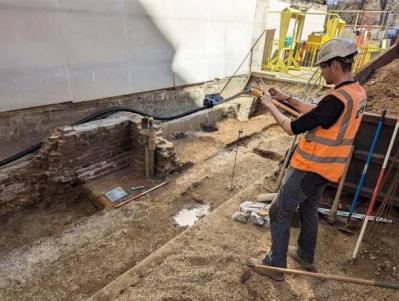 London - Archaeologists digging at the northern end of Trafalgar Square found evidence that Saxon London’s center was bigger and extended further west long ago than previously believed. A Saxon town known as Lundenwic once stood where London’s National Gallery now stands, say experts who have found evidence including a hearth from the 7th or 8th century. “The evidence we uncovered suggests the urban centre of Lundenwic extends further west than originally thought. This was made all the more exciting by having the chance to share that information, and how it relates to archaeology across London, with young people from this city” says Stephen White, senior archaeologist with Archaeology South-East. The walled Roman city of Londinium was abandoned by its inhabitants in the fifth century CE. With the arrival of the Saxons, the settlement shifted west along the modern Strand. By the seventh century, it was referred to as Lundenwic and functioned mainly as a waterfront trading hub. The National Gallery is located at the western end of this settlement; while excavations in the surrounding area have previously yielded Saxon material, this is the first excavation to show that the urban center extended this far west. Archaeologists unearthed a hearth, postholes, stakeholes, pits, ditches, and leveling deposits, which initial interpretations suggest represent the reworking of fence lines and evolving property boundaries in this western suburb of Lundenwic. The hearth was radiocarbon-dated and revealed a date range between 659-774 AD for the earliest occupation. Above this sequence of Saxon layers were post-medieval walls. The team noticed the walls were fixed up and changed over the following centuries as the area transformed. The Roman city of Londinium fell into a long, slow decline beginning in the third century AD and was eventually abandoned. The new Saxon settlers saw no need for a walled city. They eventually established a new town, Lundenwic, outside the city walls. Lundunwic grew to be the area’s main port and trading hub, with ‘wic’ meaning Saxon for trading place.
London - Archaeologists digging at the northern end of Trafalgar Square found evidence that Saxon London’s center was bigger and extended further west long ago than previously believed. A Saxon town known as Lundenwic once stood where London’s National Gallery now stands, say experts who have found evidence including a hearth from the 7th or 8th century. “The evidence we uncovered suggests the urban centre of Lundenwic extends further west than originally thought. This was made all the more exciting by having the chance to share that information, and how it relates to archaeology across London, with young people from this city” says Stephen White, senior archaeologist with Archaeology South-East. The walled Roman city of Londinium was abandoned by its inhabitants in the fifth century CE. With the arrival of the Saxons, the settlement shifted west along the modern Strand. By the seventh century, it was referred to as Lundenwic and functioned mainly as a waterfront trading hub. The National Gallery is located at the western end of this settlement; while excavations in the surrounding area have previously yielded Saxon material, this is the first excavation to show that the urban center extended this far west. Archaeologists unearthed a hearth, postholes, stakeholes, pits, ditches, and leveling deposits, which initial interpretations suggest represent the reworking of fence lines and evolving property boundaries in this western suburb of Lundenwic. The hearth was radiocarbon-dated and revealed a date range between 659-774 AD for the earliest occupation. Above this sequence of Saxon layers were post-medieval walls. The team noticed the walls were fixed up and changed over the following centuries as the area transformed. The Roman city of Londinium fell into a long, slow decline beginning in the third century AD and was eventually abandoned. The new Saxon settlers saw no need for a walled city. They eventually established a new town, Lundenwic, outside the city walls. Lundunwic grew to be the area’s main port and trading hub, with ‘wic’ meaning Saxon for trading place.
https://arkeonews.net/saxon-london-was-bigger-than-previously-believed/
ITALIE – 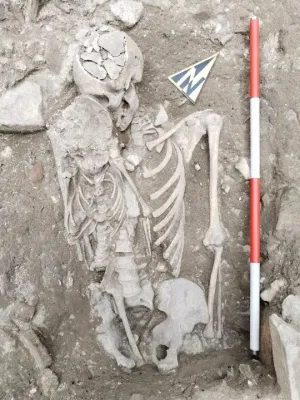 Fano - Two medieval skeleton of what are thought to be a mother embracing a young child has been unearthed in Italy. The discovery was made after workers carried out renovation works on a square called Piazza Costa in the coastal town of Fano, in Presaro Urbino province. The skeletons are definitely of an adult and child, and initial indications suggest the former is female, according to Ilaria Venanzoni, an archaeologist from the Superintendence of Fine Arts and Landscape for Ancona and Pesaro Urbino. She told Italian news agency ANSA: ‘It is plausible that a family member is holding the child. A child who seems to have fallen asleep in an eternal sleep, under the protective gaze of what we like to imagine today was his mother.’ She said DNA analysis of both skeletons would be able to determine whether the adult was the child’s mother. Roman remains possibly belonging to a house or thermal facility have previously been found where the skeletons were unearthed, Ms Venanzoni explained. And a church with a convent attached was built there during medieval times, she added.
Fano - Two medieval skeleton of what are thought to be a mother embracing a young child has been unearthed in Italy. The discovery was made after workers carried out renovation works on a square called Piazza Costa in the coastal town of Fano, in Presaro Urbino province. The skeletons are definitely of an adult and child, and initial indications suggest the former is female, according to Ilaria Venanzoni, an archaeologist from the Superintendence of Fine Arts and Landscape for Ancona and Pesaro Urbino. She told Italian news agency ANSA: ‘It is plausible that a family member is holding the child. A child who seems to have fallen asleep in an eternal sleep, under the protective gaze of what we like to imagine today was his mother.’ She said DNA analysis of both skeletons would be able to determine whether the adult was the child’s mother. Roman remains possibly belonging to a house or thermal facility have previously been found where the skeletons were unearthed, Ms Venanzoni explained. And a church with a convent attached was built there during medieval times, she added.
ITALIE - Venice -Traces of a long-lost medieval church are thought to have been uncovered in the Piazza San Marco—the iconic square that sits at the heart of Venice. Archaeologists had been conducting excavations at the site, known as St. Mark's Square in English, as part of a project to restore the paving stones known as masegni. It was during these works that archaeologists identified a series of walls and floor levels that they believe can be attributed to the church of San Gemignano This church was constructed in the square during the early medieval period, which lasted from the late fifth century to the 10th century. It was destroyed and rebuilt over the subsequent centuries before finally being demolished in the early 19th century. But over time, the exact location of the church was lost, according to the superintendency. In addition to the aforementioned walls and floor levels, the archaeologists also uncovered the remains of several people buried together in a tomb—a find that supports the church hypothesis. In medieval times, it was common to bury people next to or inside places of worship, according to the superintendency. It was equally common to place multiple deceased people inside the same tomb, although not necessarily at the same time.
VIDEO = https://www.newsweek.com/long-lost-medieval-church-uncovered-famous-venice-square-1872952?piano_t=1
ALLEMAGNE – 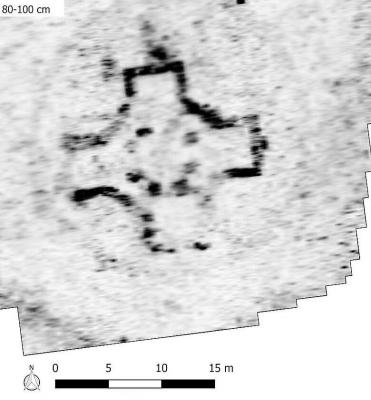
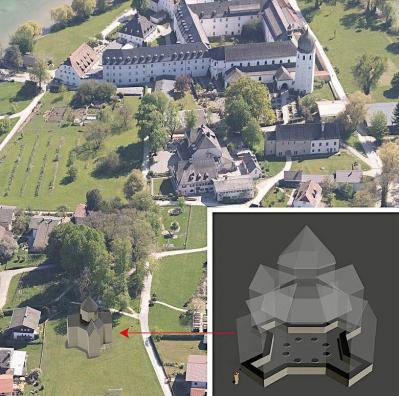 Fraueninsel - On Fraueninsel, an island in Germany’s Lake Chiemsee, archaeologists discovered a cult site that may have been slumbering underground for 1,000 years while searching for the remains of a 600-year-old church destroyed in the early 1800s. The discovery of the foundation of a 600-year-old church marked and was noteworthy in and of itself. However, when the radar technology descended 20 to 40 inches below this artifact from the Middle Ages, it revealed something even more remarkable. An older, eight-sided Romanesque building stood there, a rare example of Bavarian architecture and a sign of a hugely significant discovery. Perhaps the history of Frauenwörth Abbey on Fraueninsel in Chiemsee now needs to be rewritten. The building development was probably carried out by Duke Tassilo III. The monastery, founded around 782, is considered well-researched, but relatively little is known about the rest of the island. Until now! Now, during ground radar measurements, a team from the Bavarian State Office for Monument Preservation (BLfD) unexpectedly came across the foundations of a central building that had not previously been recorded, neither in writings nor on historical maps. “In the area of the find was the church of St Martin, which belonged to the monastery and was first documented in 1393. It was located on the highest point of the island and was demolished in 1803 in the course of secularisation. But the fact that there was an older predecessor building is also a big surprise for us,” said Armin Krämmer, mayor of the municipality of Chiemsee. To pinpoint the exact location of the demolished hall church, measurements were taken on the village green north of the well-known Tassilo lime tree in the summer of 2023 as part of investigations for a municipal monument concept (KDK). At a depth of 50 to 70 centimeters, the monument conservators came across foundations whose ground plan corresponds to the view of the church on the engraving by Michael Wening published in 1701. However, the radar data also showed that there had been an older building on this site: At a depth of 80 to 100 centimeters, further foundation walls emerged completely unexpectedly but very clearly, revealing an octagonal central building with a gallery formed by eight pillars and four annexes arranged in a cross shape. Overall, the building has an impressive diameter of 19 meters. “Central buildings are rare in pre-Romanesque and Romanesque sacred architecture north of the Alps and are therefore a very individualized form of construction, which is often interpreted as a successor to the Palatine Chapel in Aachen or as an imitation of the Church of the Holy Sepulchre in Jerusalem. In Bavaria, octagonal central buildings with an inner portico have so far only been archaeologically proven with St. Andreas in Bamberg, around 1050, and St. Gallus in Würzburg, around 1130. So we are talking about an absolute rarity here,” says Mathias Pfeil, General Conservator, Bavarian State Office for the Preservation of Monuments. But how can this find be categorized historically? There may be a connection with the veneration of Blessed Irmengard, daughter of King Louis the German and great-granddaughter of Charlemagne. She was abbess of the Frauenwörth convent, which had risen to become an imperial monastery, and was buried in the abbey church in 866. Between 1001 and 1020, her tomb was opened for the removal of relics to promote her veneration. At the same time, a fundamentally new monastery building was erected, of which the gate hall, the early Romanesque abbey church and the bell tower are still preserved today. The additional memorial building, which was intended to serve as a destination for pilgrims in the style of the Church of the Holy Sepulchre in Jerusalem, was perhaps built in this context. It is now up to scientists to evaluate and carefully analyze the latest data to provide answers to the many unanswered questions. The idea of visualizing the ground plan next summer in the form of a planting and thus making it possible to experience it is currently being considered. “Bavaria’s rich cultural heritage is always good for a surprise – as the sensational discovery in Chiemgau proves once again! The foundation walls discovered during radar measurements on the Fraueninsel show that nothing really escapes the expert eyes of our monument conservators. Such a ground plan of a Romanesque central building is an absolute rarity north of the Alps. It therefore remains exciting to see how scientists will classify this find historically,” emphasizes Bavaria’s Art Minister Markus Blume (CSU).
Fraueninsel - On Fraueninsel, an island in Germany’s Lake Chiemsee, archaeologists discovered a cult site that may have been slumbering underground for 1,000 years while searching for the remains of a 600-year-old church destroyed in the early 1800s. The discovery of the foundation of a 600-year-old church marked and was noteworthy in and of itself. However, when the radar technology descended 20 to 40 inches below this artifact from the Middle Ages, it revealed something even more remarkable. An older, eight-sided Romanesque building stood there, a rare example of Bavarian architecture and a sign of a hugely significant discovery. Perhaps the history of Frauenwörth Abbey on Fraueninsel in Chiemsee now needs to be rewritten. The building development was probably carried out by Duke Tassilo III. The monastery, founded around 782, is considered well-researched, but relatively little is known about the rest of the island. Until now! Now, during ground radar measurements, a team from the Bavarian State Office for Monument Preservation (BLfD) unexpectedly came across the foundations of a central building that had not previously been recorded, neither in writings nor on historical maps. “In the area of the find was the church of St Martin, which belonged to the monastery and was first documented in 1393. It was located on the highest point of the island and was demolished in 1803 in the course of secularisation. But the fact that there was an older predecessor building is also a big surprise for us,” said Armin Krämmer, mayor of the municipality of Chiemsee. To pinpoint the exact location of the demolished hall church, measurements were taken on the village green north of the well-known Tassilo lime tree in the summer of 2023 as part of investigations for a municipal monument concept (KDK). At a depth of 50 to 70 centimeters, the monument conservators came across foundations whose ground plan corresponds to the view of the church on the engraving by Michael Wening published in 1701. However, the radar data also showed that there had been an older building on this site: At a depth of 80 to 100 centimeters, further foundation walls emerged completely unexpectedly but very clearly, revealing an octagonal central building with a gallery formed by eight pillars and four annexes arranged in a cross shape. Overall, the building has an impressive diameter of 19 meters. “Central buildings are rare in pre-Romanesque and Romanesque sacred architecture north of the Alps and are therefore a very individualized form of construction, which is often interpreted as a successor to the Palatine Chapel in Aachen or as an imitation of the Church of the Holy Sepulchre in Jerusalem. In Bavaria, octagonal central buildings with an inner portico have so far only been archaeologically proven with St. Andreas in Bamberg, around 1050, and St. Gallus in Würzburg, around 1130. So we are talking about an absolute rarity here,” says Mathias Pfeil, General Conservator, Bavarian State Office for the Preservation of Monuments. But how can this find be categorized historically? There may be a connection with the veneration of Blessed Irmengard, daughter of King Louis the German and great-granddaughter of Charlemagne. She was abbess of the Frauenwörth convent, which had risen to become an imperial monastery, and was buried in the abbey church in 866. Between 1001 and 1020, her tomb was opened for the removal of relics to promote her veneration. At the same time, a fundamentally new monastery building was erected, of which the gate hall, the early Romanesque abbey church and the bell tower are still preserved today. The additional memorial building, which was intended to serve as a destination for pilgrims in the style of the Church of the Holy Sepulchre in Jerusalem, was perhaps built in this context. It is now up to scientists to evaluate and carefully analyze the latest data to provide answers to the many unanswered questions. The idea of visualizing the ground plan next summer in the form of a planting and thus making it possible to experience it is currently being considered. “Bavaria’s rich cultural heritage is always good for a surprise – as the sensational discovery in Chiemgau proves once again! The foundation walls discovered during radar measurements on the Fraueninsel show that nothing really escapes the expert eyes of our monument conservators. Such a ground plan of a Romanesque central building is an absolute rarity north of the Alps. It therefore remains exciting to see how scientists will classify this find historically,” emphasizes Bavaria’s Art Minister Markus Blume (CSU).



